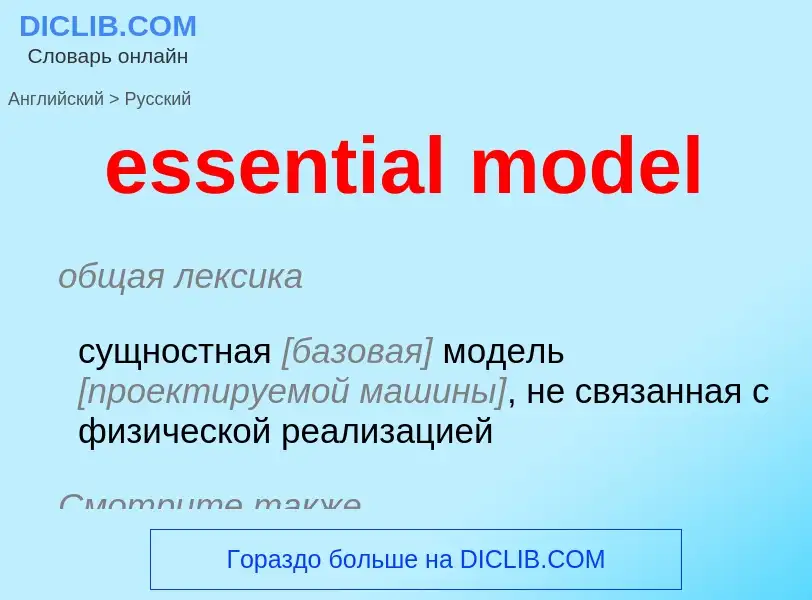Перевод и анализ слов искусственным интеллектом ChatGPT
На этой странице Вы можете получить подробный анализ слова или словосочетания, произведенный с помощью лучшей на сегодняшний день технологии искусственного интеллекта:
- как употребляется слово
- частота употребления
- используется оно чаще в устной или письменной речи
- варианты перевода слова
- примеры употребления (несколько фраз с переводом)
- этимология
essential model - перевод на Английский
общая лексика
сущностная [базовая] модель [проектируемой машины], не связанная с физической реализацией
Смотрите также
медицина
постуральный тремор
медицина
эссенциальное дрожание
эссенциальный тремор
медицина
семейный тремор
медицина
идиопатическое дрожание
[i'senʃ(ə)l]
общая лексика
существенный
основной
жизненно важный
определяющий
биохимия
незаменимый
медицина
идиопатический
эссенциальный
прилагательное
общая лексика
непременный
обязательный
необходимый
составляющий сущность
относящийся к сущности
к существу
основной
неотъемлемый
присущий
существенный
существенно важный
составляющий сущность, неотъемлемый
необходимый, весьма важный, ценный
редкое выражение
полный
совершенный
специальный термин
эфирный
относящийся к эфирному маслу
медицина
идиопатический
первичный (о заболевании)
синоним
существительное
[i'senʃ(ə)l]
общая лексика
обыкн. сущность
неотъемлемая часть
основное
самое главное
предметы первой необходимости
основные жизненные блага (пища, одежда, жильё)
военное дело
основные предметы снабжения
нефтегазовая промышленность
модель долговечности
математика
статистическое моделирование
математика
вероятностная модель
математика
генетическая модель
Википедия

Essential medicines, as defined by the World Health Organization (WHO), are the medicines that "satisfy the priority health care needs of the population". These are the medications to which people should have access at all times in sufficient amounts. The prices should be at generally affordable levels. Since 1977, the WHO has published a model list of essential medicines, with the current (2019) list for adult patients containing over 400 medicines. Since 2007, a separate list of medicines intended for child patients has been published. Both the WHO adult and children's lists contain a notation indicating that a particular medication is "complementary", thus essentially there are two lists, the "core list" and the "complementary list". The core list presents a list of minimum medicine needs for a basic health care system, listing the most efficacious, safe and cost-effective medicines for priority conditions. Priority conditions are selected on the basis of current and estimated future public health relevance, and potential for safe and cost-effective treatment. The complementary list presents essential medicines for priority diseases, for which specialized diagnostic or monitoring facilities are needed. In case of doubt medicines may also be listed as complementary on the basis of higher costs or less attractive cost-effectiveness in a variety of settings. The list is important because it forms the basis of national drugs policy in more than 155 countries, both in the developed and developing world. Many governments refer to WHO recommendations when making decisions on health spending. Countries are encouraged to prepare their own lists taking into consideration local priorities. Over 150 countries have published an official essential medicines list.



![Inspiration]]'' (1915), the second non-pornographic American film containing nude scenes. Inspiration]]'' (1915), the second non-pornographic American film containing nude scenes.](https://commons.wikimedia.org/wiki/Special:FilePath/Audrey Munson as nude art model in movie Inspiration (1915).jpg?width=200)
![''Model writing postcards'' by [[Carl Larsson]] (1906) ''Model writing postcards'' by [[Carl Larsson]] (1906)](https://commons.wikimedia.org/wiki/Special:FilePath/Carl Larsson Model writing postcards 1906.jpg?width=200)
![''[[The Art of Painting]]'' by [[Johannes Vermeer]], c. 1666 ''[[The Art of Painting]]'' by [[Johannes Vermeer]], c. 1666](https://commons.wikimedia.org/wiki/Special:FilePath/Jan Vermeer - The Art of Painting - Google Art Project.jpg?width=200)
![Nude study by [[William Mortensen]] Nude study by [[William Mortensen]]](https://commons.wikimedia.org/wiki/Special:FilePath/KOPPITZ 0007.jpg?width=200)
![''Portrait d'Olga dans un fauteuil'', ([[Pablo Picasso]]'s wife [[Olga Khokhlova]] in an Armchair), {1917–1918} ''Portrait d'Olga dans un fauteuil'', ([[Pablo Picasso]]'s wife [[Olga Khokhlova]] in an Armchair), {1917–1918}](https://commons.wikimedia.org/wiki/Special:FilePath/Pablo Picasso, 1917-18, Portrait d'Olga dans un fauteuil (Olga in an Armchair), oil on canvas, 130 x 88.8 cm, Musée Picasso, Paris, France.jpg?width=200)


![Life class at the [[Ringling Museum of Art]] in [[Sarasota, Florida]], 1947 Life class at the [[Ringling Museum of Art]] in [[Sarasota, Florida]], 1947](https://commons.wikimedia.org/wiki/Special:FilePath/Scene from a life class at the Ringling Museum of Art in Sarasota, Florida.jpg?width=200)

![were excluded from the life room]] until late in that century. were excluded from the life room]] until late in that century.](https://commons.wikimedia.org/wiki/Special:FilePath/École des beaux-arts (from the live).jpg?width=200)







